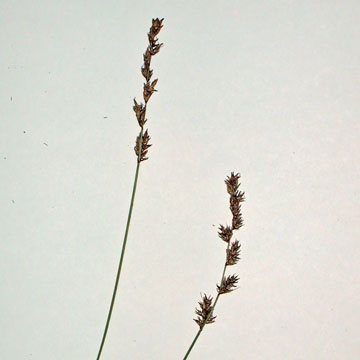

Carex prairea - (image 1 of 5)
Taxonomy
Family: Cyperaceae
Section Heleoglochin
Section Heleoglochin forms a natural group with sections Multiflorae and Vulpinae, all of which have very short, slender, tough, dark brown to blackish rhizomes, sheath fronts dotted red or copper, and relatively short anthers (1-2.5 mm).
Habitat
Swamps, wet meadows, wet prairies, rich fens, generally preferring calcareous habitats.
Associates
Distribution
Quebec to Saskatchewan, south to NJ, OH, and IA.
Morphology
Stems clustered, 50-100 cm, aphyllopodic, somewhat exceeding the leaves; main leaves 2-3 mm wide; sheaths prolonged 2-3 mm beyond the base of the blade, strongly copper-red and truncate at the apex ventrally; spikes androgynous, numerous, small, sessile, aggregated into a thick spiciform inflorescence; inflorescence 3-8 cm long, usually interrupted proximally, compound, at least the lowest nose with 2 or 3 spikes; scales reddish-brown, lance-ovate, as long as and largely concealing the perigynia; perigynia brown, dull, lance-ovate, 2.5-3 mm long and half as wide, tapering to a serrulate pale beak nearly as long as the body, flat to low-convex and nearly nerveless ventrally, broadly rounded and strongly few-nerved dorsally, the main nerves divergent well above the base.
Notes
Fruiting June to July
Wetland indicator: FACW
Similar to C. diandra which has a thin, often depressed pale median strip on the dorsal surface of the perigynium and has the ventral side of the sheaths red-dotted towards the apex. In C. prairea the apex of the sheath is strongly copper-red. While C. prairea is more likely to be found in calcareous areas, the two species are sometimes found growing together.
References
Gleason, Henry A. and A. Cronquist. 1991. Manual of Vascular Plants of
Northeastern United States and Adjacent Canada. Second Ed.
The New York Botanical Garden. Bronx, NY
|
© Michael Hough 2018 |